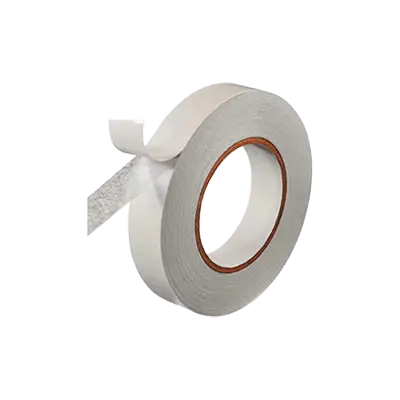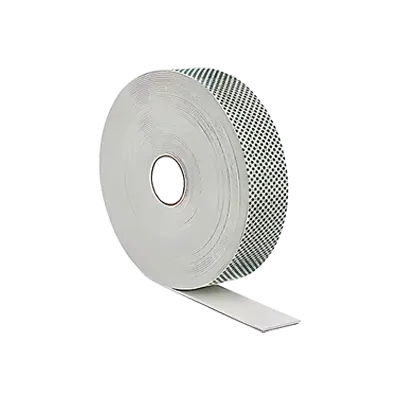Call +(254) 703 030 000 / 751 483 999 / 721 704 777
- Home
- Adhesives Sealants And Tape
- Tape
- Mounting Bonding Tape Dispensers
- Double Sided Tape Tape Shapes
.....Read More
Frequently Asked Questions
What is double-sided foam tape used for?
Double-sided foam tape is a versatile adhesive product used for bonding, mounting, and securing objects. It consists of a foam core coated on both sides with a pressure-sensitive adhesive, providing strong adhesion and cushioning properties. This tape is commonly used in various applications due to its ability to conform to irregular surfaces and provide a durable bond.
In the construction and automotive industries, double-sided foam tape is used for mounting mirrors, emblems, and trim, as well as for sealing and gasketing applications. Its ability to absorb vibrations and resist temperature changes makes it ideal for these environments.
In the home and office, it is used for hanging pictures, posters, and lightweight decorations without the need for nails or screws. It is also employed in crafting and DIY projects for attaching materials like paper, fabric, and plastic.
In the electronics industry, double-sided foam tape is used for securing components, insulating, and providing shock absorption. It is often used in the assembly of devices like smartphones and tablets.
Retail and signage industries use this tape for mounting displays, signs, and promotional materials, as it provides a clean and professional finish without visible fasteners.
Overall, double-sided foam tape is valued for its ease of use, strong adhesion, and ability to bond a wide range of materials, making it a popular choice across various sectors.
How do you apply double-sided tape?
1. **Select the Right Tape**: Choose a double-sided tape suitable for your project, considering factors like surface type, weight, and environmental conditions.
2. **Prepare the Surfaces**: Clean both surfaces where the tape will be applied. Use a damp cloth or alcohol-based cleaner to remove dust, dirt, and grease. Ensure the surfaces are dry before proceeding.
3. **Measure and Cut the Tape**: Measure the length of tape needed for your application. Use scissors or a utility knife to cut the tape to the desired length.
4. **Apply the Tape**: Peel off one side of the tape’s protective backing. Carefully align the tape with the edge of the first surface. Press down firmly to ensure good adhesion. If the tape is on a roll, unroll it gradually as you press it onto the surface.
5. **Remove the Second Backing**: Once the tape is securely attached to the first surface, peel off the second protective backing. Be careful not to touch the exposed adhesive to avoid reducing its stickiness.
6. **Align and Press the Second Surface**: Carefully align the second surface with the tape. Once aligned, press down firmly to ensure a strong bond. Apply even pressure across the entire area where the tape is applied.
7. **Secure the Bond**: For optimal adhesion, apply additional pressure using a roller or by pressing with your hands. Hold the surfaces together for a few seconds to ensure the tape bonds well.
8. **Check the Bond**: Ensure the surfaces are securely attached. If necessary, apply additional tape or pressure to areas that need reinforcement.
9. **Allow Time to Set**: For maximum strength, allow the tape to set for a few hours or as recommended by the manufacturer before putting any stress on the bond.
Can double-sided tape be used on walls?
Yes, double-sided tape can be used on walls, but its effectiveness and suitability depend on several factors.
Firstly, the type of wall surface is crucial. Smooth, non-porous surfaces like painted drywall, tiles, or glass are ideal for double-sided tape, as they allow for better adhesion. Textured or porous surfaces, such as brick, concrete, or wallpaper, may not provide a strong bond, and the tape might not adhere well or could damage the surface upon removal.
Secondly, the weight of the item being hung is important. Double-sided tape is suitable for lightweight items like posters, small picture frames, or decorative elements. For heavier objects, specialized heavy-duty double-sided tapes or alternative mounting solutions like hooks or nails might be necessary.
The type of double-sided tape also matters. There are various tapes designed for specific purposes, such as foam tapes for uneven surfaces, removable tapes for temporary applications, and permanent tapes for long-term use. Choosing the right type ensures better performance and minimizes potential damage.
Environmental conditions can affect the tape's performance. High humidity, temperature fluctuations, or exposure to direct sunlight can weaken the adhesive over time, leading to failure.
Finally, consider the potential for damage upon removal. Some double-sided tapes are designed to be removable without leaving residue or damaging the wall, while others may peel paint or leave sticky residues. Testing a small, inconspicuous area first can help assess the tape's impact on the wall surface.
In summary, while double-sided tape can be used on walls, selecting the appropriate type and considering the wall surface, item weight, and environmental conditions are essential for successful application and removal.
What surfaces can double-sided tape adhere to?
Double-sided tape can adhere to a wide variety of surfaces, depending on the type and quality of the tape. Here are some common surfaces:
1. **Smooth Surfaces**: Double-sided tape works well on smooth surfaces like glass, metal, and polished wood. The even texture allows for maximum contact and adhesion.
2. **Painted Walls**: It can adhere to painted surfaces, though the strength of adhesion may vary based on the paint type and finish. Caution is advised to prevent paint damage upon removal.
3. **Plastic**: Many types of plastic surfaces, such as acrylic and polycarbonate, are suitable for double-sided tape, provided they are clean and dry.
4. **Paper and Cardboard**: Ideal for lightweight applications, double-sided tape is commonly used in crafts and packaging.
5. **Fabric**: Some tapes are designed to adhere to textiles, useful for temporary hemming or attaching fabric to other surfaces.
6. **Wood**: Both finished and unfinished wood can be suitable, though the texture and porosity may affect adhesion.
7. **Ceramic and Tile**: Smooth ceramic tiles can hold double-sided tape well, making it useful for bathroom and kitchen applications.
8. **Stone and Concrete**: Rougher surfaces like stone and concrete may require a stronger, industrial-grade tape for effective adhesion.
9. **Foam and Rubber**: Certain tapes are designed to adhere to foam and rubber, often used in automotive and industrial settings.
10. **Vinyl**: Vinyl surfaces, such as flooring or decals, can also be suitable for double-sided tape.
For optimal adhesion, surfaces should be clean, dry, and free of dust or grease. The specific type of double-sided tape (e.g., foam, acrylic, or cloth-backed) should be chosen based on the surface material and the intended application.
How do you remove double-sided tape without damaging surfaces?
To remove double-sided tape without damaging surfaces, follow these steps:
1. **Heat Application**: Use a hairdryer or heat gun on a low setting to gently warm the tape. This softens the adhesive, making it easier to remove. Hold the heat source a few inches away and move it back and forth over the tape for about 30 seconds.
2. **Peeling**: Start at one corner of the tape and slowly peel it back. Use your fingers or a plastic scraper to lift the edge. Pull the tape back at a 45-degree angle to minimize surface damage.
3. **Adhesive Remover**: If residue remains, apply a commercial adhesive remover or rubbing alcohol. Test on a small, inconspicuous area first to ensure it doesn't damage the surface. Let it sit for a few minutes to break down the adhesive.
4. **Scraping**: Use a plastic scraper or an old credit card to gently scrape off the softened adhesive. Avoid metal tools as they can scratch the surface.
5. **Cleaning**: Wipe the area with a damp cloth to remove any remaining adhesive remover or residue. For stubborn spots, repeat the adhesive remover application and scraping process.
6. **Final Touch**: Clean the surface with a mild soap solution and water to remove any lingering chemicals. Dry with a soft cloth.
7. **Surface Protection**: If the surface is delicate, consider applying a protective wax or polish to restore its original finish.
By following these steps, you can effectively remove double-sided tape while minimizing the risk of surface damage.
Is double-sided tape waterproof?
Double-sided tape is not inherently waterproof. While some double-sided tapes are designed to be water-resistant, meaning they can withstand exposure to moisture or humidity to a certain extent, they are not fully waterproof. The level of water resistance depends on the materials and adhesive used in the tape's construction.
Certain double-sided tapes are specifically engineered for outdoor or wet environments and may feature a waterproof adhesive and backing. These tapes can be used in applications where they might come into contact with water, such as in bathrooms or for outdoor signage. However, even these tapes have limitations and may not perform well under prolonged or direct exposure to water, such as submersion.
For applications requiring waterproof properties, it is essential to choose a tape specifically labeled as waterproof or designed for outdoor use. Additionally, the surface to which the tape is applied should be clean and dry to ensure optimal adhesion and performance.
In summary, while some double-sided tapes offer water resistance, they are not universally waterproof. Selecting the right type of tape for the intended environment and application is crucial for achieving the desired results.
What is the difference between foam tape and film tape?
Foam tape and film tape differ primarily in their composition, structure, and applications.
Foam tape is made from a foam substrate, typically polyurethane, polyethylene, or acrylic. It is characterized by its thickness, compressibility, and cushioning properties. Foam tape is often used for applications requiring gap filling, sound dampening, or vibration absorption. Its adhesive is usually pressure-sensitive, allowing it to bond well to uneven or textured surfaces. Foam tape is commonly used in automotive, construction, and electronics industries for mounting, sealing, and insulating purposes.
Film tape, on the other hand, is made from a thin, flexible film substrate such as polyester, polypropylene, or PVC. It is generally thinner and less compressible than foam tape. Film tape is valued for its strength, clarity, and resistance to moisture and chemicals. It is often used for applications requiring a smooth, durable surface, such as labeling, packaging, and surface protection. The adhesive on film tape is also pressure-sensitive, but it is designed to provide a strong bond on smooth, flat surfaces.
In summary, foam tape is thicker, compressible, and used for cushioning and gap-filling applications, while film tape is thinner, strong, and used for surface protection and labeling.


